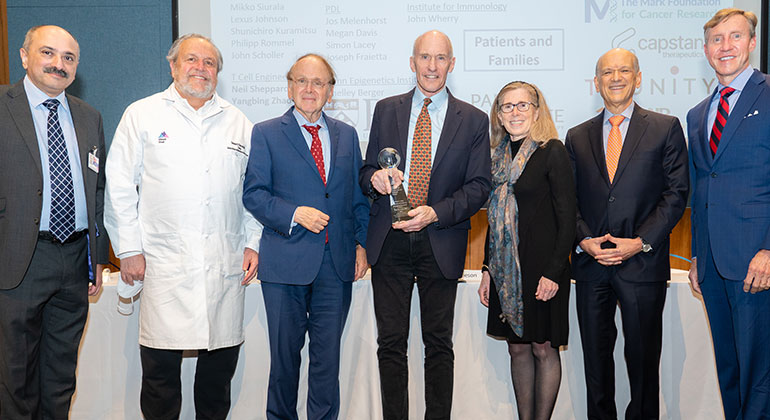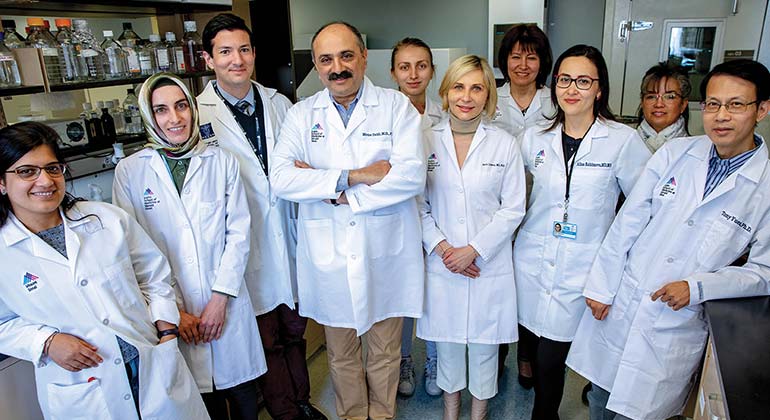New Technology Transforms Research in Viral Biology
By Revealing How Real Viruses Infect Real Cells, the Technology Promises to Provide Insights that Will Improve Viral Therapy
Researchers at The Mount Sinai Medical Center have developed an innovative system to test how a virus interacts with cells in the body — to see, for example, what happens in lung cells when a deadly respiratory virus attacks them.
In the journal Cell Host & Microbe, investigators say such a technique will not only speed basic research into viral biology, it will also help scientists improve vaccine production, generate novel antiviral compounds, and advance the development of viruses that attack cancer cells.
“We have a powerful system in place today to investigate ways in which viruses interact with cells, which has yielded fundamental insights. But has significant limitations such as cost, difficulty of use, and the problem that the cells we have to use are not in any way physiologically relevant to the virus we want to study,” said the senior investigator, Benjamin tenOever, PhD, Fishberg Professor in the Department of Medicine and Department of Microbiology at the Icahn School of Medicine at Mount Sinai.
“The new system that we developed is much less costly, can be transferrable from the study of one virus to another, and, best of all, allows us to use the real virus in the real environment it infects,” Dr. tenOever said.
Both the old and new systems essentially do the same thing—they test the effect of the virus on every one of the “host factors” in a cell. Given that genomes encode about 25,000 different genes, each of which produces a different protein or molecule, researchers test what happens to viral growth and replication when each of those 25,000 factors are silenced.
“By systematically silencing every one of those host cell factors, we can theoretically pinpoint a single protein that allows a virus to grow quickly, or another one that stops viral infection,” Dr. tenOever said.
The technique in use today employs small interfering RNA (siRNA) molecules to silence the expression of genes in the host cell — a robotic arm introduces a distinctive siRNA to small populations of human or animal cells.
But the system requires cells that are easy to grow as a substitute for natural cells. Immortal cancer cells or fibroblasts (connective cells) are often used, “which are not relevant in any way to the cells that most viruses attack. In order to study viruses this way, researchers have to modify them so that they can grow in these cells. This doesn’t represent an accurate disease model,” Dr. tenOever said. “If you want to know how flu viruses cause disease, you really want to look in the lungs or lung tissue of mammals — which has not been possible in this kind of screen.”
To make that possible, the researchers gave viruses the capacity to make those siRNAs — eliminating the need for robots to administer individual siRNAs to individual host cells.
“We created a virus family identical in all respects, except that each member of the family carries a different siRNA,” Dr. tenOever says. “So in this swarm of viral soldiers, each one has a very small trick up its sleeve—it can silence one thing in the host cell. And because of this, we can use the cells that viruses actually infect—such as lung cells.”
The researchers modified an alphavirus — a class of viruses that includes a microbe that produces encephalitisso that 10,000 family “members” each carried a distinct siRNA — which acts as a barcode of sorts. Then they allowed the virus to infect mice by mimicking the natural route of infection, such as a mosquito bite, and “let nature do its work,” Dr. tenOever said. “We let evolution select for those viruses whose individual capacity to eliminate one thing gives them the growth advantage to outgrow their brothers and sisters.”
A week after the modified virus infection, researchers were able to “see” which virus grew faster than others, and could read the barcode that indicated which gene was silenced. They could also pinpoint the viruses that quickly died in cells. Such findings not only help researchers understand how the virus operates within the cell it infects, but also reveal excellent host targets for which to design antiviral drugs.
Once the virus family is generated for study, it can be amplified, so there is no need to re-engineer the virus library again, he added.
This screening system will likely have many clinical care applications, Dr. tenOever said. “It could be used to generate cell cultures that allow enhanced vaccine production. You could improve the capacity of a therapeutic virus to get into a particular tissue, to kill tumor cells, or to chase after metastatic cancer cells,” he said. “There is potentially no end to uses of this technology.”
The research was supported in part by the US Army Research Laboratory and the US Army Research Office under grant numbers W911NF-12-R-0012 and W911NF-08-1-0413.
Researchers from Columbia University also contributed to the study.
About the Mount Sinai Health System
Mount Sinai Health System is one of the largest academic medical systems in the New York metro area, with more than 43,000 employees working across eight hospitals, over 400 outpatient practices, nearly 300 labs, a school of nursing, and a leading school of medicine and graduate education. Mount Sinai advances health for all people, everywhere, by taking on the most complex health care challenges of our time — discovering and applying new scientific learning and knowledge; developing safer, more effective treatments; educating the next generation of medical leaders and innovators; and supporting local communities by delivering high-quality care to all who need it.
Through the integration of its hospitals, labs, and schools, Mount Sinai offers comprehensive health care solutions from birth through geriatrics, leveraging innovative approaches such as artificial intelligence and informatics while keeping patients’ medical and emotional needs at the center of all treatment. The Health System includes approximately 7,300 primary and specialty care physicians; 13 joint-venture outpatient surgery centers throughout the five boroughs of New York City, Westchester, Long Island, and Florida; and more than 30 affiliated community health centers. We are consistently ranked by U.S. News & World Report's Best Hospitals, receiving high "Honor Roll" status, and are highly ranked: No. 1 in Geriatrics and top 20 in Cardiology/Heart Surgery, Diabetes/Endocrinology, Gastroenterology/GI Surgery, Neurology/Neurosurgery, Orthopedics, Pulmonology/Lung Surgery, Rehabilitation, and Urology. New York Eye and Ear Infirmary of Mount Sinai is ranked No. 12 in Ophthalmology. U.S. News & World Report’s “Best Children’s Hospitals” ranks Mount Sinai Kravis Children's Hospital among the country’s best in several pediatric specialties.
For more information, visit https://www.mountsinai.org or find Mount Sinai on Facebook, Twitter and YouTube.

Researchers Identify Potential Target for Treatment Among Patients With Type 2 Diabetes
Aug 04, 2022 View All Press Releases

